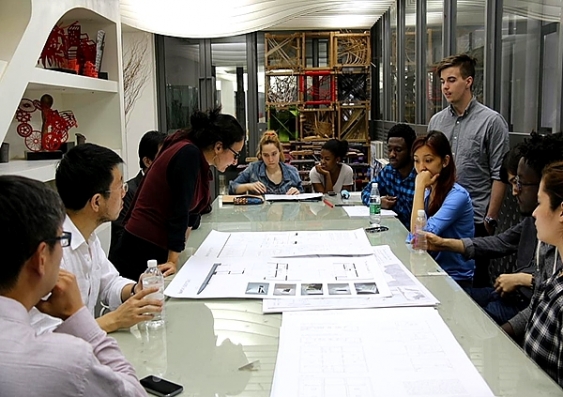Students enrolled in the UNSW/Tongji dual degree architecture university study in both Australia and China and graduate with two degrees in four years.
Johannes Welander completed the first three semesters of his degree at Tongji University in China, and has started his second year at UNSW. Originally from Sweden, he moved to Shanghai and is now living in Sydney so is a great example of a 'global citizen'.
UNSW Built Environment caught up with Johannes to see how he’s settling in, and to ask what it is like to study in China and how architecture differs between the three countries he’s lived in.
Where did you grow up?
I was born and raised in the city of Gothenburg, which lies on the west coast of Sweden, pretty much exactly on the opposite side of the world from where I am now.
Did you move to China because of this course or were there other reasons?
I had never envisioned living in China before hearing of this program, mainly as I’ve never quite heard of anything like it. My father, who works as an engineer at Volvo, was offered a job in Shanghai at roughly the same time, which in hindsight might have had some part in my choice.
Have you always wanted to study architecture?
Like many, my past has been made up of many different dreams of future careers. I’ve always seen myself as a creative person and I’ve always enjoyed drawing. The dream of becoming an architect started as soon as I heard about the profession. In Sweden, students are given the option of trying a profession for two weeks in the eighth grade. After seeing it first hand at one of Gothenburg’s leading architecture firms, I’ve always known I’d love to be an architect.
What made you choose UNSW/Tongji degree? How did you find out about the course?
I started looking at studying architecture abroad, and naturally, both Tongji and UNSW were mentioned as having some of the world’s best programs. How I came to find this particular program was through a combination of browsing UNSW’s architecture program and hearing about the dual degree from my family. The choice became not only logical, but a challenge to try something very different and become a pioneer of the new program.
What has been the most important aspect to your Tongji life?
The Tongji life has been extensively different from my past life in Sweden. Living in one of the world’s fastest growing cities is an experience well suited for an architecture student. The change in culture, architecture and social life has greatly opened my perspectives and has definitely enriched me in countless experiences.
What has been the most important aspect to your UNSW life?
While I’ve only been here at UNSW for a short while, the experience has been great. Being a European student, the culture of the university, the city and the nation, has been easier to adapt to. However with a new country come new challenges and facing challenges in new ways is what architecture is all about. From a student’s perspective, learning new methods and new ways to think about architecture, is something that would greatly aid one in finding solutions for challenges posed.
How does architecture differ between Sweden, China and Australia?
Gothenburg is very different compared to either Shanghai or Sydney. It’s a low-rise city, with a much smaller population as well as population density. The older city core is heavily influenced by 17th century Dutch architecture. Wood and bricks make up much of the exterior fabric of the built environment with a strong presence of vegetation surrounding them. This is much contrast to Shanghai’s rather small vegetation and problem with pollution.
What kind of career do you hope to have after you graduate?
I’m hoping for an opportunity to work in a very dynamic and mixed environment in the future where each project is considered unique and will be processed as such. I’d love to challenge myself in terms of architectural fields and use the international experience to my advantage.
What are some differences between Tongji and UNSW?
The layout of Tongji and UNSW differs quite a lot. In Tongji, our classes were usually much smaller, with a higher number of teachers per student. We also had significantly more classes per week, in comparison to UNSW and more time was spent at school, whilst you’re freer to study where you want.
How different is student life outside of lectures?
Many students at Tongji ended up living on campus and as such, socializing was much easier when everybody lived in close vicinity. I myself lived quite far off campus, in the French Concession area but due to Shanghai’s fantastic transport system that wasn’t much of a problem. Many of us ended up befriending many of the other international students and architectural exchange students.
What has been the challenge with moving countries while studying?
Adapting to a new country, understanding its local customs and dealing with formal applications of course takes quite some time to grasp. With a limited amount of time in each country, the whole ordeal can become a bit intensive. The layout of the program creates a very rewarding schedule that constantly keeps us motivated with amazing experiences.
Are you living on campus?
I’m currently living on campus in the Colombo House College. While it is expensive, I would definitely recommend it for anyone who is new to Sydney, as there are lots of different activities that you can sign up for, through school, flatmates and the college itself.
Do you have a favourite place in Sydney yet?
Sydney is a truly beautiful city with lots of unique places. I love going for runs in Centennial Park, which is located quite close to campus. It’s a perfect study break to get some fresh air, motivation and exercise.


